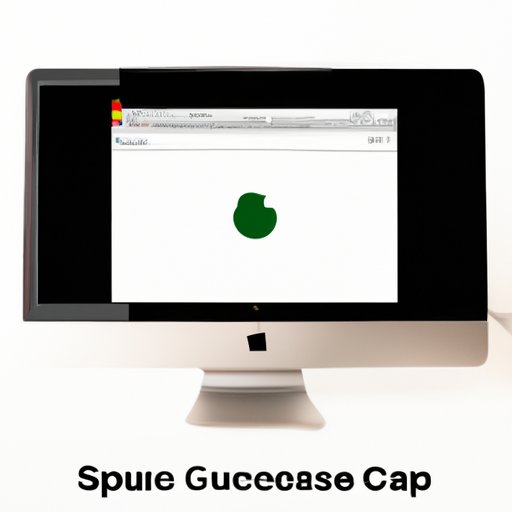
Introduction
If you’re a Mac user, you may need to capture your screen every now and then. It could be to share something with a friend, a colleague, or to create a tutorial video. This article will guide you through various methods of capturing your screen on a Mac, using the default keyboard shortcuts, third-party software, browser extensions, and the Preview app. We’ll also provide some troubleshooting tips for commonly faced issues. Whether you’re a beginner or a seasoned user, this article will help you capture screen on Mac with ease.
Using the Default Mac Screenshot Shortcut
The easiest way to capture a screenshot on a Mac is to use the keyboard shortcut Command + Shift + 3 to capture the entire screen. This will save the image as a .png file on your desktop.
If you’d like to capture a specific area of the screen, use the Command + Shift + 4 keyboard shortcut. This will turn your cursor into a crosshair, allowing you to select a specific area of the screen to capture.
There are a few other shortcuts you can use for specific types of screenshots. For example, Command + Shift + 5 allows you to customize your screenshot options, and Command + Shift + 6 captures a screenshot of the Touch Bar on newer MacBook models.
To access and save screenshots captured using the keyboard shortcuts, simply look for the .png file on your desktop. It’ll be named based on the date and time it was captured.
Utilizing Third-Party Screen Recording Software
While the default keyboard shortcuts are great for basic screenshots, third-party screen recording software can provide more control and flexibility over capturing the screen. Some popular options for Mac OS include Snagit, ScreenFlow, and Camtasia.
Snagit is a great option for capturing screenshots or recording video of your screen. The software offers a host of features and allows you to capture scrolling windows, panoramic shots, and animated GIFs. ScreenFlow and Camtasia, on the other hand, are geared more towards video editing and screen recording. Both of these software offer tools for recording, editing, and sharing videos.
If you’re unsure how to use these software, many websites offer video tutorials that can guide you through the process step by step.
Exploring Screen Capturing Alternatives
While using the default keyboard shortcuts or third-party software is great, there may be times when you don’t have access to either option. When this happens, there are still alternative methods for capturing a screen. One potentially useful method is using a digital camera to take a photo of the screen. This method is not ideal, but it may work in a pinch.
Another alternative method is to use the Grab utility, which is included with all Macs. This tool allows you to take screenshots of the entire screen, a specific window, or a selection of the screen. To access the Grab utility, go to Applications > Utilities > Grab.
Capturing Screenshots with Browser Extensions
Browser extensions can also be used to capture web pages or specific elements. Lightshot and Skitch are two popular extensions for Mac that can capture screenshots. Once installed, these extensions allow you to capture and annotate screenshots directly from your browser.
To install a browser extension, simply visit the extension’s web page and follow the instructions provided by the browser.
Using the Preview App for Screen Capturing
The Preview app on a Mac is not just for viewing images and PDFs, but it also allows you to capture screenshots. To capture a screenshot with the Preview app, simply follow these steps:
1. Open the Preview app
2. Go to File > Take Screenshot
3. Select the type of screenshot you want to take (selection, window, or screen)
4. Follow the on-screen instructions to capture your screenshot.
5. Once captured, the screenshot will appear in a new window in the Preview app, where you can edit or save it.
Going Beyond Still Screenshots with Video Capture
Sometimes a still screenshot isn’t enough, and you need to capture video of your screen. QuickTime Player is a great tool for recording video on a Mac. It’s included with every Mac and can be easily accessed from your Applications folder.
To record video of your screen with QuickTime Player, follow these steps:
1. Open QuickTime Player
2. Go to File > New Screen Recording
3. Follow the on-screen instructions to customize your screen recording settings
4. Click on the red record button to begin recording your screen
5. Once finished, press the stop button and save your recording.
QuickTime Player also allows you to edit and share your videos right from the app.
Troubleshooting Common Screen Capturing Issues
While capturing screen on a Mac is generally straightforward, sometimes you may run into issues. Some common issues include:
– Screenshot saving in the wrong location
– Low quality image capture
To solve these issues, try the following:
– Check your settings to make sure you’re saving your screenshots in the location you want.
– Adjust your screen resolution. Higher resolution settings will result in better quality screenshots.
Conclusion
Screen capturing on a Mac can be done in a variety of ways, from the default keyboard shortcuts to third-party software or browser extensions. The Preview app is also a great tool for capturing screenshots. Whether you need a still screenshot or video, there are many options available to you. Experiment with different methods until you find the one that works best for your needs.





